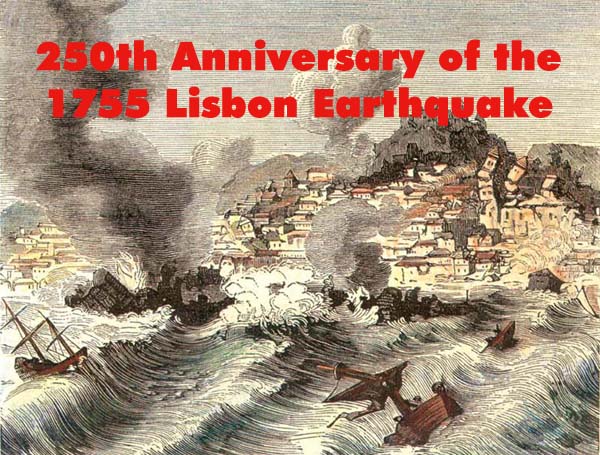

Carta de James
O’Hara
Lisboa, 12 de
Novembro, 1755
"Querida
irmã,
Sento-me para te relatar a catástrofe horrorosa que se abateu
sobre a até então florescente cidade de Lisboa, agora uma
cena de horror e desolação.
No primeiro dia deste mês, às nove e meia da manhã,
um súbito terramoto fez tremer as suas fundações, e
deixou-a em ruínas. Nesta fatal hora, as igrejas estavam
cheias; e como o seu desmoronamento foi imediato, não tendo
havido tempo para fugir, aqueles que lá estavam foram
esmagados.
É impossível descrever o ar aterrorizado dos habitantes,
tentando fugir de qualquer modo para evitar a destruição.
Inúmeros acorreram à margem do rio com esperança de
salvar as duas vidas por meio de embarcações. O cais da
alfândega pensava-se um lugar seguro; mas infelizmente foi
logo inundado, e todos aqueles que por ali fugiram, só
escaparam de uma cidade em desmoronamento para ali encontrar uma
morte na água. Pais e mães à procura dos seus
filhos, e crianças procurando os seus
pais."
O Terramoto de 1755, como
ficou conhecido, aconteceu no dia 1 de Novembro de 1755 às
9h20m da manhã, resultando na quase total destruição
da cidade de Lisboa e de grande parte do litoral do Algarve. O
sismo foi seguido de um tsunami que se crê terá atingido
a altura de 20 metros e múltiplos incêndios, tendo feito
mais de 100 mil vítimas mortais. Foi um dos mais
mortíferos terramotos da história.
 O terramoto teve um enorme impacto na sociedade
do Século XVIII, em especial na estrutura política em
Portugal e tornou-se o primeiro estudo cientifico do efeito de um
terramoto numa área alargada. Os geólogos modernos
estimam que o sismo de 1755 atingiu 9 graus na escala
Richter.
O terramoto teve um enorme impacto na sociedade
do Século XVIII, em especial na estrutura política em
Portugal e tornou-se o primeiro estudo cientifico do efeito de um
terramoto numa área alargada. Os geólogos modernos
estimam que o sismo de 1755 atingiu 9 graus na escala
Richter.
O terramoto fez-se sentir
na manhã de 1 de Novembro, no feriado católico do dia de
Todos-os-Santos. Relatos contemporâneos afirmam que o
terramoto durou, consoante o local, entre seis minutos e 2 horas e
meia, causando fissuras gigantescas de cinco metros que cortaram o
centro da cidade de Lisboa. Com os vários desmoronamentos os
sobreviventes procuraram refúgio na zona portuária e
assistiram ao abaixamento das águas, revelando o fundo do mar,
cheio de destroços de navios e cargas perdidas. Dezenas de
minutos depois um enorme tsunami de 20 metros fez submergir o porto
e o centro da cidade. Nas áreas que não foram afectadas
pelo tsunami, o fogo logo se alastrou, e os incêndios duraram
pelo menos 5 dias.
Lisboa não foi a
única cidade portuguesa afectada pela catástrofe. Todo o
sul de Portugal, nomeadamente o Algarve, foi atingido e a
destruição foi generalizada. As ondas de choque do
terramoto foram sentidas por toda a Europa e norte da África.
Os tsunamis originados por este terramoto varreram desde a
África do norte até ao norte da Europa, nomeadamente
até à Finlândia e através do Atlântico,
afectando locais como Martinica e Barbados.
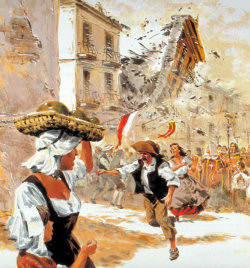 De uma população de 275 mil habitantes
em Lisboa, 90 mil foram mortos. Outros 10 mil foram vitimados em
Marrocos. Cerca de 85% das construções de Lisboa foram
destruídas, incluindo palácios famosos e bibliotecas,
igrejas, hospitais e todas as estruturas. Várias das
construções que sofreram pouco danos pelo terramoto foram
destruídas pelo fogo que se seguiu ao abalo
sísmico.
De uma população de 275 mil habitantes
em Lisboa, 90 mil foram mortos. Outros 10 mil foram vitimados em
Marrocos. Cerca de 85% das construções de Lisboa foram
destruídas, incluindo palácios famosos e bibliotecas,
igrejas, hospitais e todas as estruturas. Várias das
construções que sofreram pouco danos pelo terramoto foram
destruídas pelo fogo que se seguiu ao abalo
sísmico.
O Marquês do Pombal,
primeiro-ministro de D. José, sobreviveu ao terramoto. Com o
pragmatismo que caracterizou a sua governação, iniciou
imediatamente a reconstrução de Lisboa. A sua rápida
resolução levou a organizar equipas de bombeiros para
combater os incêndios e recolher os milhares de cadáveres
para evitar epidemias. O ministro e o rei, contrataram arquitectos
e engenheiros, e em menos de um ano depois do terramoto, já
não se encontravam ruínas em Lisboa e os trabalhos de
reconstrução iam adiantados. O rei desejava uma cidade
nova e ordenada a construção de grandes praças e
avenidas largas e rectilíneas, que marcaram a planta da nova
cidade. Na altura alguém perguntou ao Marquês de Pombal
para que serviam ruas tão largas, ao que este respondeu que um
dias elas serão pequenas... o que se reflecte hoje no
trânsito caótico de Lisboa.
O novo centro da cidade,
hoje conhecido por baixa pombalina é uma das
atracções turísticas da cidade. São os
primeiros edifícios mundiais a serem construídos com
protecções anti-sismo, que foram testados em modelos de
madeiras à medida que as tropas marchavam ao seu
redor
A competência do
ministro não se limitou à acção de
reconstrução da cidade. O Marquês do Pombal ordenou
um inquérito, enviado a todas as paróquias do país
para apurar a ocorrência e efeitos do terramoto. O
questionário incluía, entre outras
questões: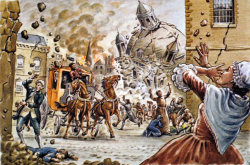
Quanto tempo durou o
terramoto?
Quantas réplicas se sentiram?
Que tipo de danos causou o terramoto?
Os animais tiveram comportamentos estranhos? (esta questão
antecipou estudos sismológicos chineses, da década de
1960)
Que aconteceu nos poços?
As respostas estão
ainda arquivadas na Torre do Tombo. Através das respostas do
inquérito foi possível aos cientistas actuais recolherem
dados fiáveis e reconstituírem o fenómeno de uma
perspectiva científica. O inquérito do Marquês do
Pombal foi a primeira iniciativa de descrição objectiva
no campo da sismologia, razão pela qual o Marquês do
Pombal é considerado um percursor da ciência da
sismologia.
As causas geológicas
do terramoto e da actividade sísmica na região de Lisboa
são ainda causa de debate científico. Apesar de existirem
indícios geológicos da ocorrência de grandes abalos
sísmicos com a periodicidade de aproximadamente 300 anos,
Lisboa encontra-se no centro de uma placa tectónica, não
existindo assim justificação para um terramoto tão
intenso. Alguns geólogos avançam que o terramoto
estará relacionado com o desenvolvimento de uma zona de
subducção no Oceano Atlântico, e com o início
do fecho deste oceano.
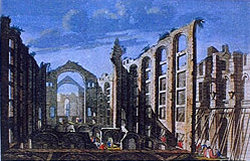 .
. 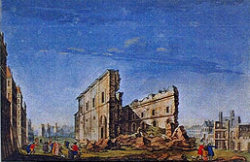 .
. 

Letter from James
O’Hara
Lisbon, November 12, 1755
"Dear
sister,
I sit down to relate to you the dreadful catastrophe that has
befallen the once-flourishing city of Lisbon, now a scene of horror
and desolation.
On the first day
of this month, at half past nine in the forenoon, a sudden
earthquake shook its foundations, and laid it in ruins. At this
fatal hour, the churches were crowded; and as their fall was
momentary, and allowed no time for retreating, those who were in
them were crushed to death.
It is impossible to describe the affrighted looks of the
inhabitants, flying various ways to avoid destruction. Numbers
flocked to the river’s side in hopes to save their lives by
means of boats. The custom-house quay was imagined to be a place
for safety; but unhappily it was soon inundated, and those who fled
on it, only escaped from the falling city, to meet a watery grave.
Fathers and mothers were seen seeking their children, and children
searching for their parents."
The 1755 Lisbon earthquake
took place on November 1, 1755, at 9:20 in the morning. It was one
of the most destructive and deadly earthquakes in history, killing
well over 100,000 people. The quake was followed by a tsunami and
fire, resulting in the near total destruction of Lisbon. The
earthquake accentuated political tensions in Portugal and
profoundly disrupted the country's 18th century colonial ambitions.
The event was widely discussed by European Enlightenment
philosophers, and inspired major developments in theodicy and in
the philosophy of the sublime. The first to be studied
scientifically for its effects over a large area, the quake
signaled the birth of modern seismology. Geologists today estimate
the Lisbon earthquake approached magnitude 9 on the Richter
scale.
 The earthquake struck on the morning of November
1, the All Saints' Day Catholic holiday. Contemporary reports state
that the earthquake lasted between three-and-a-half and six
minutes, causing gigantic fissures five meters wide to rip apart
the city center. The survivors rushed to the open space of the
docks for safety and watched as the water receded, revealing a sea
floor littered by lost cargo and old shipwrecks. Several tens of
minutes after the earthquake, an enormous tsunami engulfed the
harbor and downtown, rushing up the Tagus river. It was followed by
two more waves. In the areas unaffected by the tsunami, fire
quickly broke out, and flames raged for five days.
The earthquake struck on the morning of November
1, the All Saints' Day Catholic holiday. Contemporary reports state
that the earthquake lasted between three-and-a-half and six
minutes, causing gigantic fissures five meters wide to rip apart
the city center. The survivors rushed to the open space of the
docks for safety and watched as the water receded, revealing a sea
floor littered by lost cargo and old shipwrecks. Several tens of
minutes after the earthquake, an enormous tsunami engulfed the
harbor and downtown, rushing up the Tagus river. It was followed by
two more waves. In the areas unaffected by the tsunami, fire
quickly broke out, and flames raged for five days.
Lisbon was not the only
Portuguese city affected by the catastrophe. Throughout the south
of the country, in particular the Algarve, destruction was general.
The shockwaves of the earthquake were felt throughout Europe as far
as Finland and North Africa. Tsunamis up to 20 meters in height
swept the coast of North Africa, and struck Martinique and Barbados
across the Atlantic. A three-meter tsunami hit the southern English
coast.
Of a Lisbon population of
275,000, up to 90,000 were killed. Another 10,000 were killed in
Morocco. Eighty-five percent of Lisbon's buildings were destroyed,
including famous palaces and libraries, as well as most examples of
Portugal's distinctive 16th-century Manueline architecture. Several
buildings that had suffered little damage due to the earthquake
were destroyed by the fire.
It is said that many
animals sensed danger and fled to higher ground before the water
arrived. The Lisbon quake is the first documented reporting of such
a phenomenon in Europe.
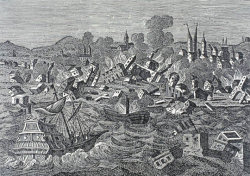 The Prime Minister Sebastião de Melo (the
Marquis of Pombal) survived the earthquake and said: “Now?
Bury the dead and feed the living”, and with the pragmatism
that characterized his coming rule, he immediately began organizing
the recovery and reconstruction. He sent firefighters into the city
to extinguish the flames, and ordered teams to remove the thousands
of corpses. Time was short to dispose of the corpses before disease
spread. Contrary to custom and against the wishes of
representatives of the Church, many corpses were loaded onto barges
and buried at sea beyond the mouth of the Tagus. To prevent
disorder in the ruined city, and, in particular, as a deterrent
against looting, gallows were constructed at high points around the
city and at least 34 were executed. The Portuguese Army was
mobilized to surround the city to prevent the able-bodied from
fleeing, so that they could be pressed into clearing the ruins. Not
long after the initial crisis, the prime minister and the King
quickly hired architects and engineers, and less than a year later,
Lisbon was already free from debris and undergoing reconstruction.
The King was keen to have a new, perfectly ordained city. Big
squares and rectilinear, large avenues were the mottos of the new
Lisbon. At the time, somebody asked the Marquis of Pombal the need
of such wide streets. The Marquis answered: one day they will be
small. Indeed, the chaotic traffic of Lisbon today reflects the
wisdom of the reply.
The Prime Minister Sebastião de Melo (the
Marquis of Pombal) survived the earthquake and said: “Now?
Bury the dead and feed the living”, and with the pragmatism
that characterized his coming rule, he immediately began organizing
the recovery and reconstruction. He sent firefighters into the city
to extinguish the flames, and ordered teams to remove the thousands
of corpses. Time was short to dispose of the corpses before disease
spread. Contrary to custom and against the wishes of
representatives of the Church, many corpses were loaded onto barges
and buried at sea beyond the mouth of the Tagus. To prevent
disorder in the ruined city, and, in particular, as a deterrent
against looting, gallows were constructed at high points around the
city and at least 34 were executed. The Portuguese Army was
mobilized to surround the city to prevent the able-bodied from
fleeing, so that they could be pressed into clearing the ruins. Not
long after the initial crisis, the prime minister and the King
quickly hired architects and engineers, and less than a year later,
Lisbon was already free from debris and undergoing reconstruction.
The King was keen to have a new, perfectly ordained city. Big
squares and rectilinear, large avenues were the mottos of the new
Lisbon. At the time, somebody asked the Marquis of Pombal the need
of such wide streets. The Marquis answered: one day they will be
small. Indeed, the chaotic traffic of Lisbon today reflects the
wisdom of the reply.
Pombaline buildings are
among the first seismically-protected constructions in the world.
Small wooden models were built for testing, and earthquakes were
simulated by marching troops around them. Lisbon's "new" downtown,
known today as the Pombaline Downtown (Baixa Pombalina), is one of
the city's famed attractions. Sections of other Portuguese cities,
like the Vila Real de Santo António in Algarve, were also
rebuilt along Pombaline principles.
The Prime Minister's
response was not limited to the practicalities of reconstruction.
The Marquis ordered a query sent to all parishes of the country
regarding the earthquake and its effects. Questions
included:
How
long did the earthquake last?
How many aftershocks were felt?
What kind of damage was caused?
Did animals behave strangely? (this question anticipated studies by
Chinese seismologists in the 1960s)
What happened in wells and water holes?
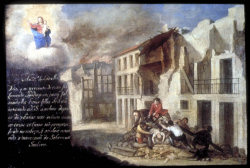 The answers to these and other questions are
still archived in the Tower of Tombo, the national historical
archive. Studying and cross-referencing the priests' accounts,
modern scientists were able to reconstruct the event from a
scientific perspective. Without the query designed by the Marquis
of Pombal, this would have been impossible. Because the Marquis was
the first to attempt an objective scientific description of the
broad causes and consequences of an earthquake, he is regarded as a
forerunner of modern seismological scientists.
The answers to these and other questions are
still archived in the Tower of Tombo, the national historical
archive. Studying and cross-referencing the priests' accounts,
modern scientists were able to reconstruct the event from a
scientific perspective. Without the query designed by the Marquis
of Pombal, this would have been impossible. Because the Marquis was
the first to attempt an objective scientific description of the
broad causes and consequences of an earthquake, he is regarded as a
forerunner of modern seismological scientists.
The geological causes of
this earthquake and the seismic activity in the region continue to
be discussed and debated by contemporary scientists. Some
geologists have suggested that the earthquake may indicate the
early development of an Atlantic subduction zone, and the beginning
of the closure of the Atlantic Ocean.

A
cache:
ATENÇÃO: Esta cache, em
memória do 250º aniversário do terramoto de 1755, em
Lisboa, será activada apenas no
dia comemorativo desse fatídico acontecimento, 1 de Novembro
de 2005.
Nesta mesma ocasião, entre 1
e 4 de Novembro, decorrerá em Lisboa uma conferência
internacional comemorativa deste acontecimento, intitulada "250th Anniversary of the 1755 Lisbon
Earthquake”.
A cache encontra-se
escondida em frente ao Centro Cultural de Belém, onde
será realizada a sessão de abertura da referida
conferência, na zona ribeirinha que tanto foi afectada pelo
terramoto e consequente maremoto. Por favor seja discreto na busca
e volte a colocar o recipiente como o encontrou, para que fique bem
preso e não seja encontrado por terceiros.


The
cache:
NOTE: This cache, to commemorate the
250th anniversary of the 1755 Lisbon earthquake, will be activated only on the 1st of November
2005, 250 years after this catastrophic day.
At the same time, between 1 and 4 November, there will be in Lisbon
an international conference commemorating this seismic event
entitled “250th Anniversary of the 1755 Lisbon
Earthquake”.
The cache is
hidden in front of the Centro Cultural de Belém, where the
opening session and the first lectures of the conference will be
carried through, in the marginal zone that was so affected by
earthquake and consequent tsunami. Be very discrete in your search
and please put the container back in the position as you found it,
so that it is well attached and not easilly found by
“muggles”.